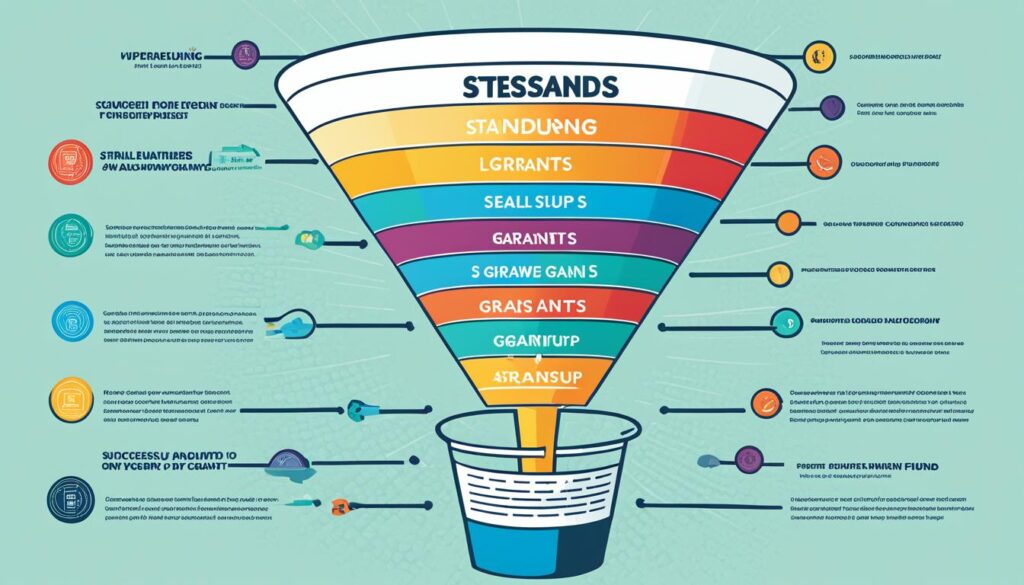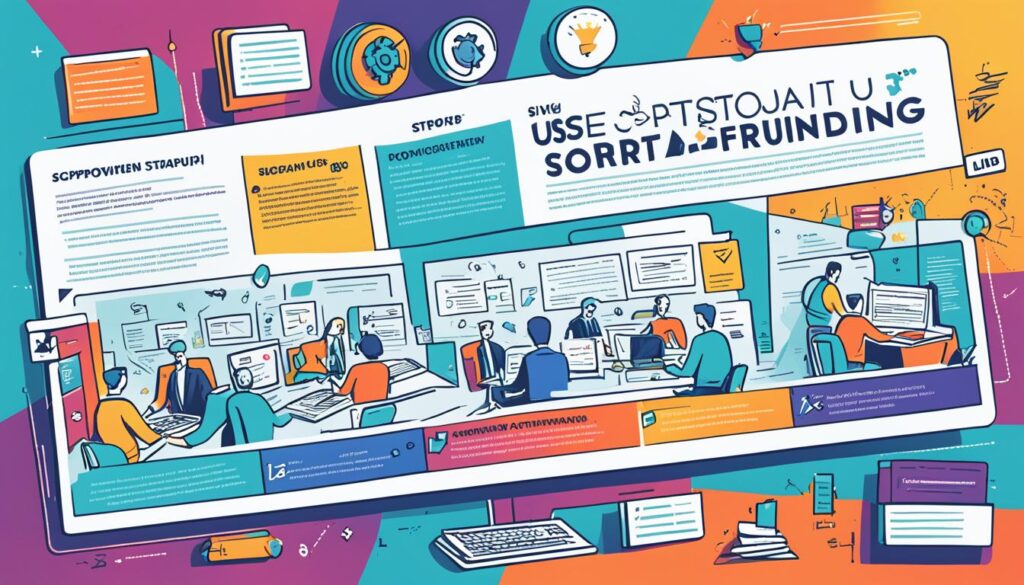Did you know that nearly 40% of businesses fail because of cash flow issues? This statistic emphasizes the importance for startups to explore all funding options available. Government grants are a valuable resource that are often overlooked. They offer financial assistance without the burden of debt, making them a desirable option.
Learning how to get government funding is vital for success. Startups find it hard to get venture capital, with success rates pretty low. This guide will show you how to get government support. It aims to help you kickstart and grow your business.
Key Takeaways
- Understanding the role of government grants can help prevent financial pitfalls.
- Government funding often presents a lower-risk option compared to venture capital.
- Only a fraction of startups successfully obtain large-scale funding, reinforcing the importance of diversifying funding sources.
- Building strong relationships can enhance your chances of winning grants.
- Local and state grants may be more accessible for new startups compared to federal options.
Understanding Government Grants for Startups
Getting funds is hard for new companies. Government grants help without needing to be paid back. Knowing what government grants definition means is key for business owners.
Definition of Government Grants
Agencies give funds to support new businesses. These grants help companies grow and innovate without owing money. They can be used for tech, hiring, and growing the business.
Many companies want these grants, so it’s competitive. You might need to be in business for a while before applying.
Benefits of Government Grants for Startups
There are big pluses to startup grant benefits:
- Access to free funding that you don’t repay.
- Money to spend on important tech or infrastructure.
- A chance to bring on skilled workers without debt.
- Support for projects that lead to new ideas.
- More recognition and a better image in the market.
Government grants can really help startups. They make a big difference when trying to stand out.
| Type of Grant | Funding Amount | Eligibility |
|---|---|---|
| Small Business Innovation Research (SBIR) | Up to $1.5 million | Innovative technology firms |
| Women’sNet Amber Grant | $10,000 monthly & $25,000 annually | Women entrepreneurs |
| FedEx Small Business Grant Contest | Up to $50,000 | Small business owners |
Types of Government Funding Available
Learning about the different types of government funding can help you find money for your startup. There are federal grants, state grants, local grants, and nonprofit funding. Each kind supports businesses in different ways.
Federal Grants
Federal grants give big support to businesses in certain areas. You can find these grants on places like Grants.gov. They help with things like tech, health research, and making the economy better. For example, the National Institute of Health (NIH) and the U.S. Department of Agriculture (USDA) have special grants for startups.
State and Local Grants
State and local grants help businesses in certain places. They are made to fit what each community needs. In 2020, Illinois gave out $3 billion for things like building projects. To find these grants, talk to the agencies that look after economic growth in your area.
Nonprofit Grants
Nonprofits give grants to startups that want to make a difference. An example is the Minnesota Emerging Entrepreneur Loan Program. It helps minority and low-income business owners get financial help. These grants are great for growing your business and helping society.

| Type of Grant | Funding Source | Target Areas |
|---|---|---|
| Federal Grants | U.S. Government | Technology, Biomedical, Economic Development |
| State Grants | State Governments | Infrastructure, Local Community Development |
| Local Grants | Municipal Authorities | Small Business Support, Community Projects |
| Nonprofit Grants | Nonprofit Organizations | Social Impact, Minority Business Support |
How to Get Startup Funding from Government
Getting funding from the government can greatly boost your startup. The first step is to find grants that fit your needs. Use resources to make your search easier, which gets you closer to finding good funding options.
Identifying Relevant Grant Opportunities
Begin with online platforms and government tools meant for grant hunting. Sites like Grants.gov are key for finding the right grants. Also, talk to local economic development agencies. They know about more grants that could be perfect for your business.
Understanding Eligibility Requirements
After finding some grants, learn about their requirements. Grants have criteria like business type, what industry you’re in, and how long you’ve been operating. Knowing these things helps you aim for grants you’re more likely to get.

Government Resources for Finding Grants
Finding the right grants for your startup is key. There are many federal, state, and local resources to help. These platforms make finding good matches for your needs easier.
Utilizing Grants.gov
Grants.gov is a main place for finding federal grants. You can search by different criteria to find what fits your business. It lists over 553 funding chances with full details and what you need to apply. Using Grants.gov can really help you get the funds you need.
Local Economic Development Agencies
Local economic agencies are great for finding funds. They know a lot about funding for local businesses. They help you understand grants for your area and how to apply for them. Working with these agencies can help you win grants locally.
Accessing State-specific Grant Listings
Every state has its own grants for businesses. These grants can be for certain industries or groups of people. Looking into resources in your state, like the Minnesota Emerging Entrepreneur Loan Program, can be very helpful. These programs are for minority and low-income owners. Knowing about them is key to getting funded.

| Resource Type | Description | Example Programs |
|---|---|---|
| Federal Grants | National funding opportunities accessible through a centralized portal. | Employee Retention Credit (ERC), NIH COVID-19 Research Grants |
| Local Economic Agencies | Community-based organizations that provide insights and support for local funding. | San Francisco Small Business Grants, U.S. Economic Development Administration Opportunities |
| State Grant Listings | State-specific funding options tailored to local businesses and demographics. | Texas Enterprise Fund, Illinois Capital Grants for Infrastructure |
Small Business Innovation Research (SBIR) Program
The Small Business Innovation Research (SBIR) program is vital for small business innovation in the U.S. Since its start in 1982, SBIR has been helping startups make important tech advancements. With funding from eleven federal agencies, it encourages private sector innovation.
Overview of the SBIR Program
Small businesses with up to 500 workers can get support for their research and development. The funding covers initial explorations in Phase I for 6 to 12 months. Those successful in Phase I may get more time and money in Phase II to further their projects.
Eligibility and Application Process
To apply for SBIR, your business must be small and focus on innovative research. The application must outline how your technology is different and the technical risks. This step is crucial in showcasing your project’s potential and alignment with federal research areas.

Small Business Technology Transfer (STTR) Program
The Small Business Technology Transfer (STTR) program is key in helping research and development. It offers funds for small businesses to work with research institutions. This is perfect for startups wanting to innovate and push technology forward. Look into the STTR program and learn how to apply for the STTR application process.
What the STTR Program Offers
The STTR program provides several advantages for innovation in research. Key benefits include:
- Funding for projects with eligible research institutions.
- Support for technologies that turn into significant commercial products.
- Various funding phases, from feasibility studies to development.
- Chances to work in fields like Artificial Intelligence and Advanced Materials.
How to Apply for STTR Grants
Navigating the STTR application process means you have to fit specific eligibility requirements. Here’s how to submit a winning proposal:
- Pick a research institution that qualifies for partnership.
- Make sure your startup is small, with less than 500 workers.
- Create a proposal that highlights innovative technology with impact.
- Apply through the right federal platforms, paying attention to deadlines.
- Use resources from places like the U.S. Small Business Administration for help.

| STTR Program Phases | Description | Duration |
|---|---|---|
| Phase I | Feasibility study of the proposed technology | Up to 6 months |
| Phase II | Technology development based on Phase I findings | Up to 2 years |
| Phase III | Technology goes to market and undergoes further development | Varies |
Understanding the STTR’s advantages and the applying process boosts your funding chances. By using the STTR program, your business might offer innovative solutions for national challenges.
Local and State Grant Programs to Consider
Exploring local and state grants can give your startup much-needed funds. These grants don’t just offer money. They also provide tips for your marketing and technical needs. This help is tailored just for you, making it vital for your business’s growth.
Marketing and Technical Assistance Grants
Local and state governments often have grants to assist startups. They help you sharpen your business tactics. Grants can fund marketing, product development, and improve your operations. These grants have big advantages:
- Access to funds without repayment obligations.
- Specific resources and expertise provided by agencies.
- Opportunities to connect with local networks and industry experts.
Industry-specific Grants
Many places have special grants for businesses in sectors like tech, healthcare, and manufacturing. These grants are designed for the unique needs of these industries. They provide money tailored to help your startup thrive. Some well-known programs are:
| Program Name | Industry Focus | Grant Range |
|---|---|---|
| Technology Development Grant | Technology | $50,000 – $250,000 |
| Healthcare Innovation Program | Healthcare | $100,000 – $500,000 |
| Manufacturing Expansion Grant | Manufacturing | $75,000 – $300,000 |
By using local and state grants focused on certain industries, your startup can grow. These grants show the power of support from your community. They help new businesses and spark innovation across different fields.

Private Funding Opportunities Complementing Government Grants
Startups often need more than government grants to grow. Many private organizations and corporations offer extra funding. They look for projects that bring new ideas, help society, or improve communities. Knowing about these sources can greatly improve your startup’s finances.
Private Nonprofit Grants
Nonprofits give out grants to help with social issues or to assist communities in need. Nonprofit grants come from organizations like:
- The Home Depot Foundation, which helps veterans with housing and skills training.
- Kroger, giving $300 million each year to various causes.
- The Wisconsin Women’s Business Initiative Corporation, which provides loans to women starting their own businesses.
Corporate Grant Programs
Many companies also give corporate grants to support innovative startups and community work. Look at these examples:
- Bank of America’s $1 billion plan for economic growth and fairness.
- Coca-Cola has given $1.5 billion to help others since it started.
- Walmart offers grants between $250 to $5,000 for community projects.
Learning about these programs can align your startup with the right funding. Mixing private funding with government aid can turn your creative ideas into reality.

| Organization | Grant Amount | Focus Area |
|---|---|---|
| Bank of America | $1 billion over four years | Economic Mobility, Racial Equity |
| Coca-Cola | $1.5 billion since inception | Charitable Initiatives |
| Kroger | $300 million annually | Community Support |
| Walmart | $250 – $5,000 | Nonprofit Projects |
| Home Depot Foundation | Varies | Veteran Support & Community Recovery |
Preparing Your Startup for Grant Applications
Getting ready to apply for grants is key to funding your startup. You need to make a solid business plan and gather important documents. Every step is crucial to show your business is worthy of a grant.
Creating a Solid Business Plan
Your business plan is the core of your grant application. It outlines your vision, strategy, and goals. Your plan must include:
- Executive Summary: A brief overview of your business and its goals.
- Market Analysis: A look at your target market, competitors, and industry trends.
- Financial Projections: Future earnings and spending for three years, showing:
| Year | Revenue | Expenses | Profit |
|---|---|---|---|
| Year 1 | $100,000 | $80,000 | $20,000 |
| Year 2 | $150,000 | $100,000 | $50,000 |
| Year 3 | $200,000 | $120,000 | $80,000 |
Gathering Necessary Documentation
We must collect key documents to strengthen your grant application. These documents include:
- Proof of Ownership: Important for minority-owned business grants.
- Business Registration: Shows your startup is officially registered.
- Licenses and Permits: Necessary for meeting industry standards.
- Financial Records: Up-to-date financials show your business’s health.
- Contracts: All contracts should be legal and valid.
Take care and be detailed in preparing these components. Your grant application represents your business. A well-prepared application can significantly improve your chances of success.

Navigating the Grant Application Process
The grant application process needs a strategic plan for better success chances. It’s key to understand the unique needs of each grant to create winning applications. Knowing helpful tips can guide you, and being aware of common mistakes can avoid unnecessary errors.
Important Tips for Successful Applications
- Tailor your application to match each grant’s specific demands.
- Use Grants.gov to find a wide range of federal grants.
- Meet people in your field at conferences and incubators for new grant opportunities.
- Build connections with program officers to get advice and make your application stand out.
- Always follow the application guidelines closely.
- Keep a detailed record of your work to show the granting agency, building a good base for future funding chances.
- Start applying early, as collecting the needed info and perfecting your proposal takes time.
Common Pitfalls to Avoid
- Missing deadlines may get you out of the running.
- Poor answers to questions may show you’re not prepared or serious.
- Not following guidelines can greatly decrease your chance of getting the grant.
- Avoiding help from grant writing pros can lead to missed chances and weak applications.

By using key tips and avoiding typical errors, your startup can be in a better position to win grants. Knowing these details can greatly boost your odds of getting funding.
Conclusion
Getting funding is a big challenge for business starters. Government grants are a great way for startups to lessen financial stress. By doing detailed research and preparing well, you can find and use different resources meant to help your business grow. The impact of government support in sparking innovation and growth is big, as seen in many successful businesses.
To better your chances for startup funding, it’s important to understand government grants. These grants come with good terms, helping you stay away from personal debt and high-interest loans. Also, getting in touch with incubators and accelerators gives you special access to startup resources. This makes your funding journey smoother and more direct.
Lastly, the U.S. startup funding scene is full of helpful options, including government grants. By knowing how to apply and matching your business goals with the grants’ criteria, you can make your startup successful. The right strategy not only helps your business but also sets the stage for ongoing innovation and growth in a tough market.









